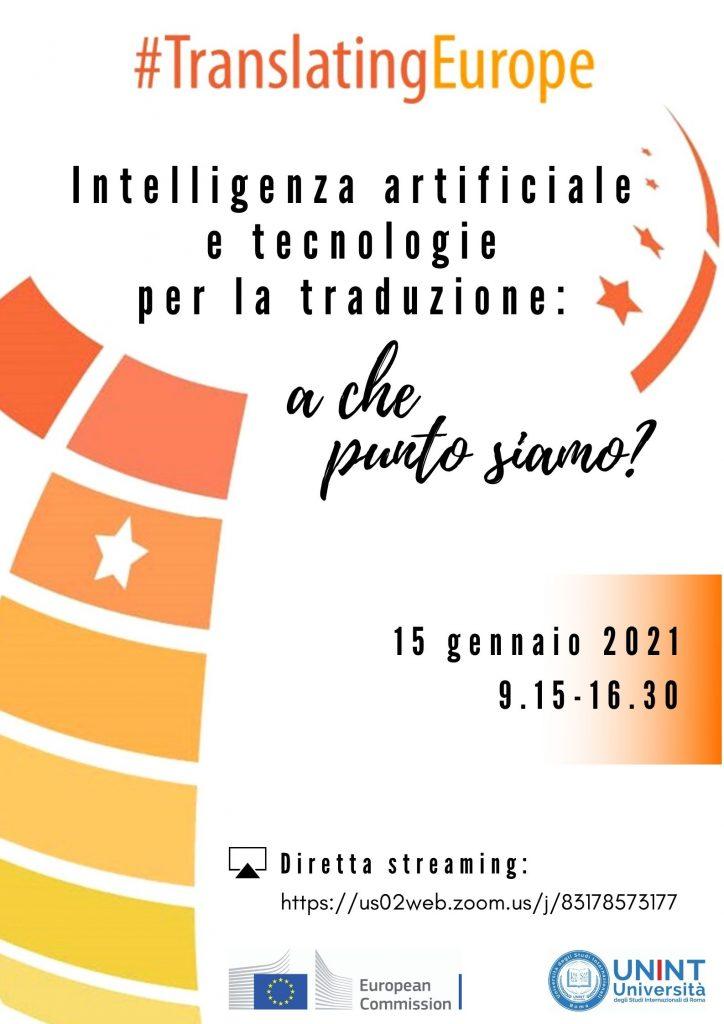
Università degli Studi Internazionali-UNINT and DGT (Rome Field Office) jointly organised a Translating Europe Workshop (TEW) on Friday 15 January 2021.
The workshop had the aim of giving an overview of the state-of-the-art on neural machine translation and speech recognition technologies. More specifically, the focus of the TEW was on how the latest trends in technology applied to translation and interpreting can support language professionals in their work and at the same time promote linguistic inclusion and accessibility to information, culture and entertainment for the general public in an ever-globalised, multilingual society (e.g. machine translation of public service webpages, automatic subtitling of plenary debates, and so on). In this sense, the workshop was thematically linked to previous events in the TEW series and was aimed at raising awareness about the added value of translation for society.
Originally envisaged as a face-to-face event, the workshop was moved to the Zoom platform in the face of the current COVID-19 crisis. In order to ensure maximum participation, the event was free of charge and no registration was required; in addition, it was also streamed via the DGT YouTube channel Translating for Europe. The working languages were English and Italian and a simultaneous interpreting service was provided as well. Speakers included academics and researchers from universities in Italy, Belgium, Germany, Ireland and the UK, including several EMT members (UNINT, Dublin City University, Ghent and Surrey); in addition, there were representatives of leading Italian companies working in this field, in order to illustrate the current situation and to highlight where R&D on these topics is going.
After the institutional greetings of DGT’s Director-General Rytis Martikonis and of UNINT’s Rector and Dean of the Faculty of Interpreting and Translation, Session 1 was devoted to introducing the two main foci of the workshop, namely neural MT and speech recognition technologies applied to translation and interpreting. The Head of the MT Unit of DGT, Markus Foti, gave a presentation on the eTranslation tool developed at the EU; this was followed by Giuseppe Daniele Falavigna and Marco Turchi, from Fondazione Bruno Kessler, who provided a brief historical overview of Automatic Speech Recognition technology (ASR) and its applications to speech translation, as well as current developments in Computer Assisted Interpreting. Both strands (neural MT and the applications of ASR to translation) were taken up in the presentations by company representatives, namely Luca De Franceschi (Translated) and Gorizio Ciancarelli and Filippo Tessaro (Pervoice). Both companies have developed a range of state-of-the-art proprietary software and are involved in several research projects, some of which were showcased for the first time during the workshop.
An important aspect related to the pervasiveness of MT in professional translation is, of course, post-editing: this was the subject of the thought-provoking presentations by Moritz Schaeffer (University of Mainz-Germesheim) and Federico Gaspari (University for Foreigners “Dante Alighieri”, Reggio Calabria). Error recognition in post-editing is especially crucial when using neural MT, whose output tends to be acceptable on the surface but may, in fact, contain errors of various kinds; in addition, several metrics for evaluating MT quality were discussed.
After a well-deserved lunch-break, the afternoon session opened with Joss Moorkens’ presentation (Dublin City University) on designing and developing an assistive translation tool, i.e. an accessible translation interface. Along similar lines, Claudio Fantinuoli and Bart Defrancq (Mainz-Germesheim and Ghent, respectively) described their project to develop an ASR-based tool designed to assist simultaneous interpreters in the booth.
The issue of how to integrate machines into the translation and interpreting workflow is another hot topic at the moment. Claudio Fantinuoli & Bianca Prandi (Mainz-Germesheim) described an experimental study in which human simultaneous interpreting is compared with the output of a speech translation system, while Elena Davitti and Tomasz Korybski (Surrey) presented two projects, SMART and MATRIC, in which different speech translation workflows are compared. While SMART is focused on fully human interlingual respeaking, MATRIC compares simultaneous interpreting with the output of a workflow made up of a respeaking component (in the same language) and an MT component. Clearly, there is a wide range of possible workflows in which different speech recognition systems (speaker-dependent or speaker-independent) and MT tools can be fruitfully integrated to assist professional interpreters and translators for specific purposes, and the field is still largely unexplored.
The event was extremely interesting and lively and attracted a lot of attention, with 380 Zoom participants in the morning and 260 in the afternoon, and many more watching via streaming on YouTube, which shows that there is a lot of interest in the topics we discussed. If you have missed it, find out all about our speakers and programme on the event web page below and watch the recordings on YouTube, made available in 3 separate sections for your convenience:
Event webpage, with programme, abstracts and speakers’ bio-notes (in English and Italian): https://www.unint.eu/it/calendario-eventi/translating-europe-workshop-2021.html
We look forward to your feedback, comments and questions, to keep the ball rolling.
AI and translation technologies-Part 1: neural machine translation
AI and translation technologies-Part 2: post-editing and localisation
AI and translation technologies-Part 3: AI and interpreting
We look forward to your feedback, comments and questions, to keep the ball rolling.
Details
- Publication date
- 3 February 2021
- Language
- Dutch
- English
- Finnish
- French
- EMT Category
- Translation technology
